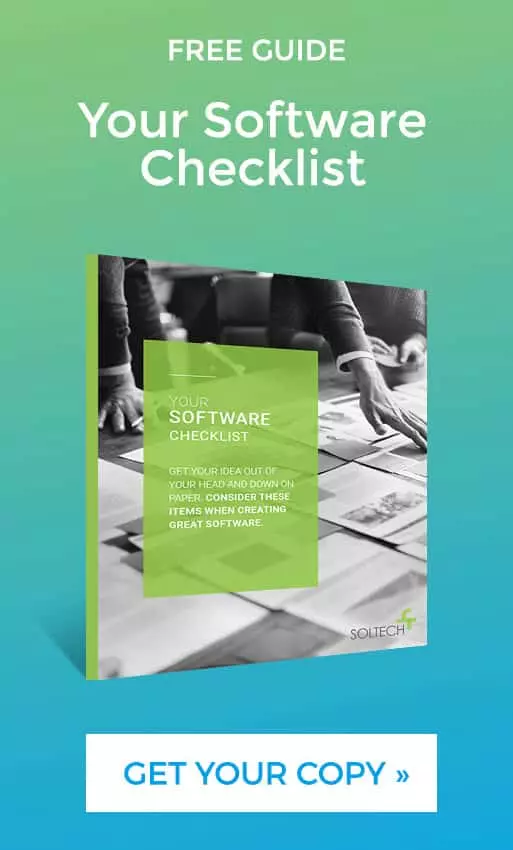
What’s the Best Tech Stack for Custom Web Applications?
By Thayer Tate
If you’re building a web app, you might be wondering “What’s the best stack for custom web applications?”. If you’re evaluating web app stacks to use in your project, you’ll find some helpful information in this post.
Developing a custom web application is a big decision for any company. However, today’s advanced tools and frameworks have made it easier than ever before to do.
On the other hand, the large variety of tools available and their ever-evolving nature presents a unique concern. All of these options can make it difficult to know what the best tech stack is for creating your custom web application.
You want to make sure the tools you are picking are current. But what if they are so current that your team has not had the chance to fully learn them?
These are just a few of the challenges that can come up as you consider web app tech stack options. That makes following a clear and defined decision-making process especially important.
Before picking your web application technology stack, you must first think about your end goals and walk through outlining your requirements. Read on to find out what other considerations are important to help you pick the right web application tech stack.
What is a tech stack?
A “tech stack” refers to the combination of technologies a company uses to build and run an application or project. This includes everything from the operating systems and servers to the programming languages, frameworks, databases, and other tools that developers use to create and maintain software.
Tech stacks are typically divided into two main components:
- Front-end (or client-side): This part of the stack involves the technologies that run on the user’s device, in their web browser or on their mobile app. It includes everything related to what users interact with directly, such as HTML, CSS, JavaScript, and front-end frameworks like React, Angular, or Vue.js.
- Back-end (or server-side): This includes the technologies that run on the server and handle the ‘behind-the-scenes’ functionality of web applications. This can include programming languages like Python, Ruby, Java, or Node.js, server-side frameworks like Django, Rails, or Express, and databases like MySQL, PostgreSQL, or MongoDB.
Additionally, a tech stack may include:
- Middleware: Software that bridges the gap between the front-end and back-end, such as authentication services, data management tools, and custom business logic.
- DevOps tools: Technologies that help in deployment, scaling, and monitoring applications, like Docker, Kubernetes, Jenkins, and cloud services such as AWS, Google Cloud, or Azure.
Choosing the right tech stack is crucial as it affects the performance, scalability, maintainability, and overall success of the application. The decision typically depends on several factors including project requirements, team expertise, budget, and specific goals like scalability or speed.
Define your web application requirements
The technology you choose for your web app may depend on the application requirements you need. It is true that the same application can often be developed in multiple different technology stacks. However, it is also true that each technology has its strengths and weaknesses.
Defining and understanding your web app’s technical requirements is the first step in making the best technology decision for your solution. Letting your needs guide the process helps your organization make more specific decisions that lead to better results.
Here are a few questions to consider:
- What do you want the app to do?
- Will it be a content-driven application, where customers can find out more about your company and products by clicking through a web page?
- Will it be an e-commerce application, where users can buy products directly through the app and pay via credit card, PayPal, or ACH?
- Will it be a highly functional and customized application used to automate your unique, internal business processes?
- What kind of data will the app handle? Does the application security model need to conform to any standards such as PCI or HIPAA?
- How many back-end systems will the app need to interface with?
The answers to each of these questions could lead you down very different technology paths. There isn’t one single web app technology stack that’s best in all situations. Finding the right stack for your web application is situational — It depends on your unique needs.
The best path forward may be implementing a content management platform, selecting an existing e-commerce platform, or building a completely custom application. Once you’ve determined your web app’s goals, you can begin the process of evaluating the technology to be used in the development process.
Choose the foundation for your web application
Typically, the first technical decision you will make is whether or not you will use an existing platform as the basis of the solution or go completely custom. Both options are very effective in certain contexts and less effective in others. Mapping out your needs helps your team make an informed decision about the best tech stack for your web app.
A platform is a pre-existing software solution that can be implemented and customized. Examples of platforms include WordPress, Shopify, Salesforce, Magento, Drupal, etc. Some platforms can also be extended using pre-built modules or libraries.
You can use these modules and libraries to speed up your development timeline, which can also impact your technology decisions. For example, WordPress, Salesforce, and Magento have large app extension marketplaces. They include hundreds of premade code modules you can add to your app quickly and easily to expand its capabilities.
If you do select a platform as the basis of your application, then your programming language choice is often made for you. Most platforms have a base technology stack that is built in. For example, if you select WordPress as a platform, then customization work will need to be programmed in PHP.
Alternatively, if you selected Salesforce as your platform, then coding will be done in APEX. APEX is Salesforce’s proprietary language that closely resembles Java.
If no existing platform provides any value to your solution and you will build it custom, then there are many language and technology choices ahead of you.
Choose your back-end programming language
You’ve defined your app requirements and decided if it will be a custom application. Now, you want to select the best programming languages for your solution.
Some of the more popular app programming languages are .NET, Java, Node.js, PHP, and Ruby, but that’s just the start. You may also find yourself considering Python, Golang, or C++ for some applications. For mobile apps, you’ll likely consider Java, Objective-C, Swift, and React Native.
Most applications tend to work with data, and you will also need database services to store information for your app. Some common database solutions include postGRES, MySQL, SQL Server, and Mongo.
One of the biggest choices you’ll make with regard to the database is whether you want to store data using a relational model or a document model. Some databases, like MySQL, are primarily used for relational data. Others, like Mongo, are used primarily for document-style data.
Whichever approach and database you select, you need to make sure that your programming language has built-in support for your selected database
So, how do you pick the right programming language for your app when there are so many fitting choices? It’s often an easier choice than it seems at first.
There’s an old adage that answers the question of which programming language is the best … “the one you can support.” It is also very important to know and consider the team that will be supporting the application once it is in production.
You should pick a technology your team can support throughout the development process. If you will build the development team from scratch, then it helps to look at the job marketplace to see what languages are well-represented by candidates, whether locally or working remotely.
Choose a front-end framework
A front-end framework can help you build, manage, and maintain the front end of your web app more easily. It’s a way for you to structure your files, make requests, style components, associate data with elements, and more.
Many developers use front-end frameworks to scale their web apps, since it makes it easier and more efficient to do on a larger scale.
Popular front-end frameworks
- Angular: A JavaScript-based open-source framework powered by Google and is used by big brands like General Motors, HBO, Forbes, Nike, and Sony. Angular is:
- Part of the MEAN stack (Mongo database, Ejb web app server framework, Angular.js, and Node.js server runtime environment)
- Compatible with a large number of code editors and offers cleaner codebases through the use of the TypeScript programming language
- Includes simple and powerful templates, IDEs, and command-line tools
- Maintained by a large community of developers
- Is best used to create dynamic websites and web apps
- React: An open-source JavaScript library from Facebook and is used by brands like Instagram, Netflix, and Dropbox. React:
- Offers a great user experience through its use of a virtual DOM (document object model)
- Reduces overall development timelines through code re-use and code hot reloading
- Web apps enjoy robust code stability through downward data binding
- Allows developers to perform faster testing cycles through Redux
- Has a large support community
- Is ideal for building dynamic user interfaces
- Vue: An open-source model-view JavaScript framework billed as an “incrementally adoptable ecosystem that scales between a library and a fully-featured framework.” Vue is:
- Built and supported by its founders
- Includes a robust set of libraries, tools, and partnerships
- Has an engaged support community
- Perfect for building user interfaces and single-page applications
Popular back-end frameworks
- Spring Boot: A Java-based framework with an extensive ecosystem and a large support community. It’s best suited for large-scale web apps that use a cloud approach.
- Express: A Node-based framework that offers fast development in a minimalist interface. It includes an extensive library of plugins that can extend your web app functionality.
- Laravel: A PHP-based framework, it offers beautiful syntax, the MVC architectural pattern, a robust ecosystem, and support community, and it can accommodate large development teams.
- CakePHP: A PHP-based framework that allows developers to build rapidly, uses clean MVC conventions, and it’s easy to use.
- Django: A Python framework that is highly customizable and scalable, and includes most everything developers need to create and deploy web apps (no third-party plugins required). It is best suited for large applications.
- Ruby on Rails: A Ruby-based framework similar to Django, but for Ruby. It offers a large library of plugins, clear syntax, and has a large support community. It’s best for smaller projects, though it can also handle larger ones if needed.
Choose your hosting option
The language you use to build your web app, the platform, and back-end services that support it will narrow down your choice of hosting solutions.
However, there will still be a plethora of hosting options available. These days, one of the cloud hosting vendors like AWS, Azure, or Google Cloud will likely come up as an early contender in the discussion.
When making a hosting decision, it is important to realize that hosting is more than just the hardware server your app will live on. The cloud also offers many services that your application may use. These include sending emails, directory services, sending push notifications, analytics, and more.
When choosing your hosting option, consider what your corporate preferences are. Do you already have a relationship with a hosting provider? What support options are available through your host?
Consider whether there are any legal implications of data storage. It’s better to think about your hosting sooner, rather than later. Making wholesale changes later in your web app development lifecycle may be difficult.
Takeaways
Making technology decisions on a new web application development project can be daunting in a world of ever-evolving technology. However, it’s also very exciting. The tools and capabilities available to developers today are truly unprecedented. With so many options for building a technology stack for web apps, you’re sure to find a combination that meets your needs.
The key is to approach the decision process in a logical and sequential manner. Crucially, you need to strike a balance between modern-day best practices and the capabilities of your support team.
Knowing what goal you’re trying to achieve with your web app, what technologies you have on hand, and what resources will work on the project is a good starting point. An experienced and talented team of professional web developers can be invaluable in this regard.
That team can choose the right tools for creating your unique and scalable web app. They know how to select the best tech stack for web apps — one that meets your needs and helps you achieve your business outcomes.
If you’re ready to start your next custom web application project, be sure to check our checklist for building great software below. It’s full of all you need to consider upfront to see your project through from start to finish. Download the checklist below.
FAQ’s
What are the key components of a tech stack for web development?
The key components of a tech stack for web development include front-end technologies such as HTML, CSS, JavaScript, and frameworks like React, Angular, or Vue.js that are used to create the user interface. Back-end technologies involve server-side languages like Python, Ruby, Java, and Node.js along with frameworks such as Django, Rails, or Express that handle the application logic, user authentication, and database interactions. Database technologies include relational databases like MySQL and PostgreSQL, or NoSQL options like MongoDB. Server and hosting technologies can involve web servers such as Apache or Nginx and cloud services like AWS, Azure, or Google Cloud Platform. Additionally, DevOps tools like Docker, Kubernetes, Jenkins, and Git support the automation of deployment, scaling, and monitoring processes.
How do I keep my tech stack up-to-date with evolving technologies?
Keeping a tech stack up-to-date involves conducting regular audits to review the effectiveness of current technologies and checking for updates or end-of-life notifications. Continuous learning and training and staying up to day with new trends and technologies. Implementing updates gradually, focusing on one component at a time, helps manage risks while ensuring system stability. Employing flexible and modular architectures like microservices also makes the system easier to update and maintain.
What are the advantages of using a modern tech stack over legacy technologies?
Using a modern tech stack offers improved performance and efficiency due to optimizations in newer software and hardware. Modern technologies typically include enhanced security features that protect against current threats and receive regular updates. They also increase developer productivity through features like automated testing, better integration capabilities, and efficient debugging tools. Modern stacks are designed to scale more easily, accommodating growth smoothly and supporting scalability with features that handle increased loads and data efficiently.
What role does scalability play in choosing a tech stack for web development?
Scalability is essential in choosing a tech stack as it ensures the application can handle growth in users and data without performance degradation. A scalable tech stack accommodates future growth and maintains performance under increasing loads, helping manage costs effectively by using resources efficiently. It also provides flexibility to expand, allowing for the addition of new features and services without significant reconfigurations. Selecting a scalable tech stack from the beginning helps in building a robust, responsive, and reliable application that supports long-term business goals and avoids the need for costly redevelopment as the application grows.
Thayer Tate
Chief Technology Officer
Thayer’s expertise expanded as he obtained his Project Management Professional (PMP) certification and joined SOLTECH, an Atlanta-based technology firm specializing in custom software development, Technology Consulting and IT staffing. During his tenure at SOLTECH, Thayer honed his skills by managing the design and development of numerous projects, eventually assuming executive responsibility for leading the technical direction of SOLTECH’s software solutions.
As a thought leader and industry expert, Thayer writes articles on technology strategy and planning, software development, project implementation, and technology integration. Thayer’s aim is to empower readers with practical insights and actionable advice based on his extensive experience.








